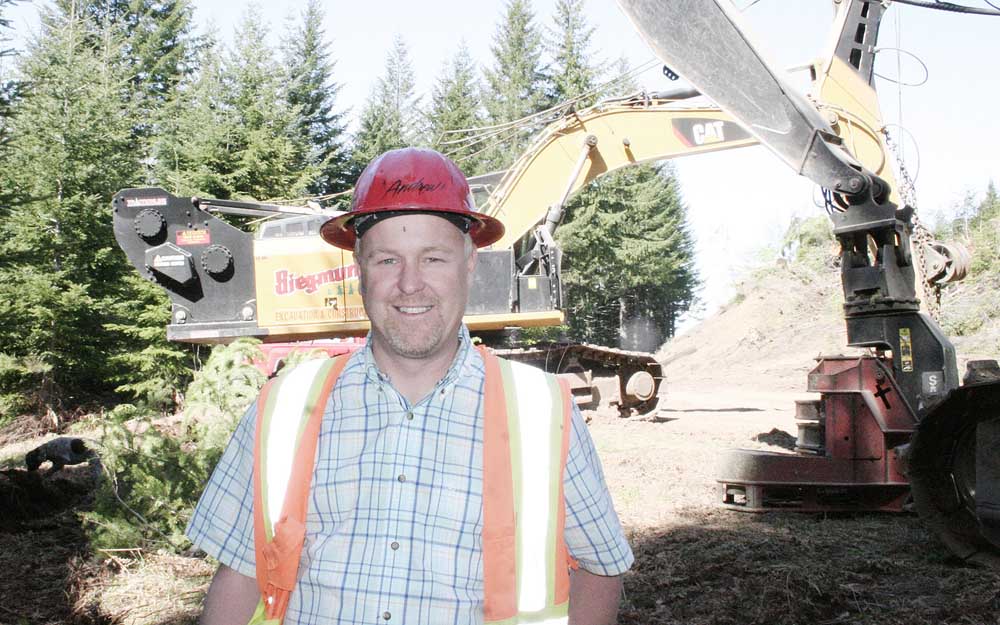No slope too steep for this rig
Published 10:49 pm Saturday, June 2, 2018

- Andrew Siegmund, head of Siegmund Excavation & Construction, stands next to tethered logging machinery that can be used on slopes of up to 100 percent, compared to 30 to 50 percent for regular machinery. The company invested in the system in 2016 shortly after returning to the logging industry.
A tethered logging system requires fewer workers, but eliminating timber jobs wasn’t why Andrew Siegmund invested in the technology.
As the number of loggers declines over time, those who remain in the industry are best deployed to areas that are inaccessible to machinery, said Siegmund, head of Siegmund Excavation & Construction of Stayton, Ore.
“It can’t do everything. You still need timber fallers, you still need choker setters,” he said. “There’s less and less of them, so you want to utilize them where they’re most needed.”
With the system used by Siegmund, a feller buncher can descend slopes of up to 100 percent while attached with two heavy cables to a modified excavator “base machine,” which serves as an anchor.
To compare, regular untethered logging machinery can operate on slopes of 30 to 50 percent.
A major advantage of logging with machinery is speed. A feller buncher can extend a 30-foot boom outfitted with a grapple saw quickly from tree to tree, instead of a logger walking to from one to the other.
“From one position, he can cut multiple stems,” Siegmund said. “There’s less fatigue. Timber fallers usually work a six-hour day, while he can work 10 and be less exhausted.”
The operator is also safer inside an enclosed cab with a rollover protective structure — a tree limb that would maim or kill a timber faller will only ding the machine’s paint job.
In addition to being equipped with a hitch to which the cables are fastened, the cutting machine’s track is lengthened by two feet and the track’s cleats, or “grousers,” are elongated by two inches for better traction.
The base machine’s counterweight is replaced with a winch assembly that’s controlled remotely from within the feller buncher, unfurling and rolling up the cables as necessary. A single operator controls both machines.
Eric Luscher, Siegmund’s cutting manager, tries to avoid soil with poor traction and spreads woody debris over certain areas to improve the track’s grip.
“I walk a lot of the units and look for that kind of stuff,” he said.
While the operator is strapped in with a four-point harness, “almost like a NASCAR driver,” tipping over the machine would still be dangerous due to the possibility of fire, Siegmund said. Leaking oil can ignite when coming into contact with a hot engine.
If an accident blocks the door, the cab has two escape hatches for the operator to get out.
In a situation where the feller buncher remains upright but can’t climb back uphill, the operator may look for an escape route downhill or wait for another machine to create a suitable trail.
“I’m still learning what it can and can’t do,” said Luscher. “Knock on wood, I’ve never got in a spot where I couldn’t get back out.”
Operating the tethered logging system required a regulatory variance from Oregon’s Occupational Health and Safety Administration, for which the company had to write an in-depth operations manual describing best practices and safety procedures.
The company also submitted a plan for alternate practices with the Oregon Department of Forestry, whose stewardship forester had to sign off on environmental practices.
Heavy machinery cannot leave deep ruts on hillsides, which can cause large amounts of soil to wash down the slope during a rain storm.
To mitigate such ruts, the cutting machine sweeps a log across the ground, raking away the depressions. A mound cutting diagonally across the slope, known as a water bar, also minimizes erosion.
Regulators have generally been open to the modified machinery and techniques, Siegmund said. “We’re all learning together. It’s a brand new technology, so we’re writing the playbook as we go.”
Before making the $1.5 million investment in the tether logging system, Siegmund was initially skeptical about the technology.
“If you buy it, will there be work for it or is it a passing fad?” he said.
Interest among large timberland owners worried about long-term labor shortages, as well as the machinery’s safety mechanisms, ultimately convinced him to take the leap.
“It looked like good, robust equipment,” Siegmund said. “We viewed it as a real opportunity.”
Siegmund’s grandfather, Ralph, founded a logging company in the late 1930s. It spawned the excavation company begun by his father, Lou, in 1970.
The two firms worked in tandem until his grandfather retired and closed the logging outfit in 1994. The excavation company kept its roots in the timber industry by building forest roads but did not return to logging until 2015.
After the downturn in the timber economy, many companies that specialized in removing trees for roads went out of business, Siegmund said.
Siegmund decided to take over that task, which required investing in machinery that could also be used for logging, he said. “It was a natural segue.”
Siegmund Excavation & Construction
Hometown: Stayton, Ore.
Employees: 48
Founded: 1970
Services: Logging, road building, excavation, quarry development, portable crushing and trucking.






